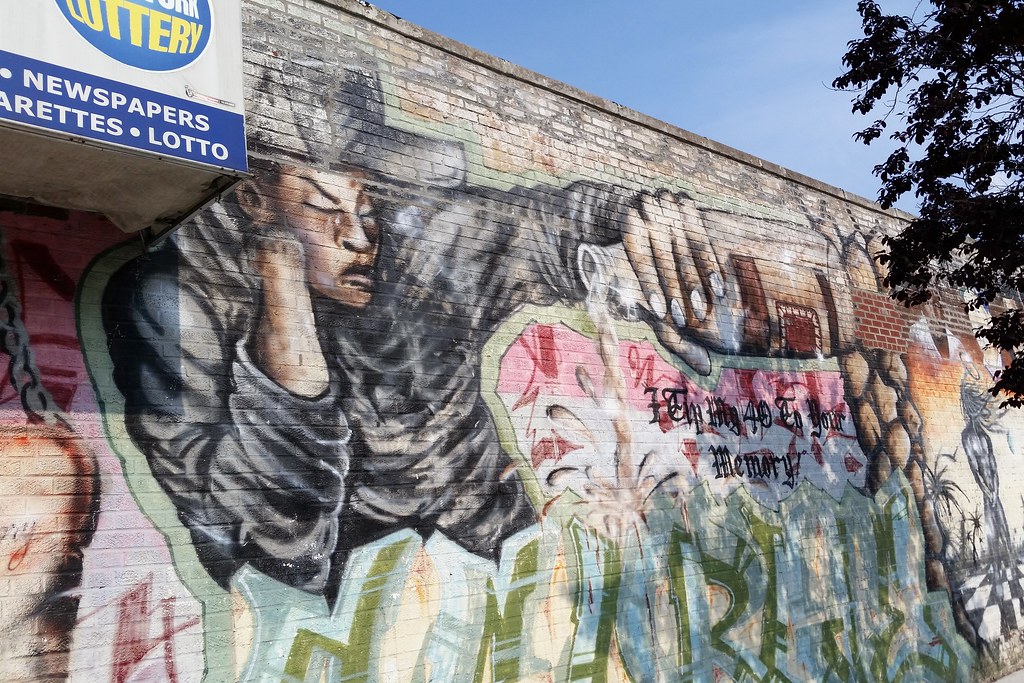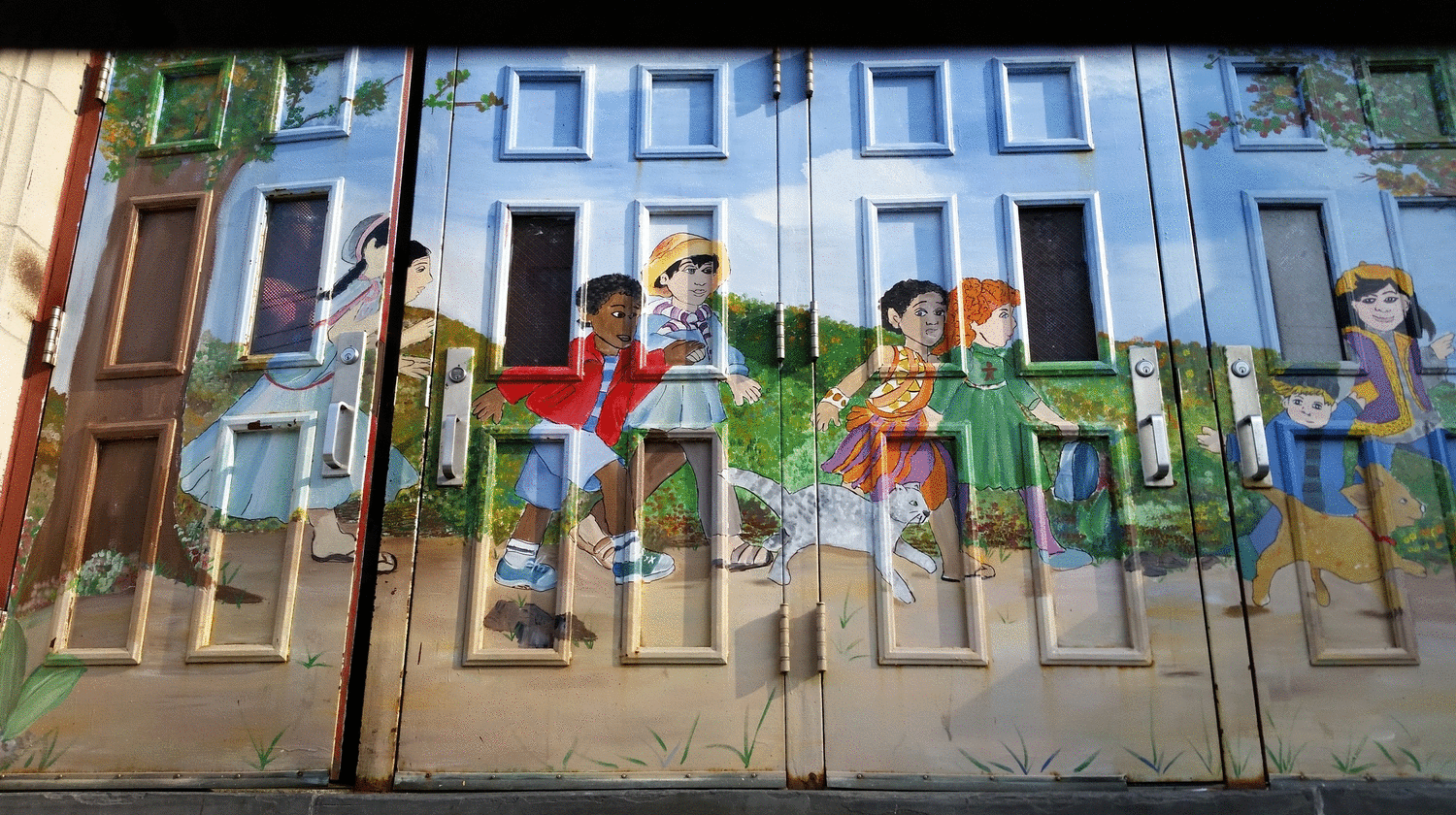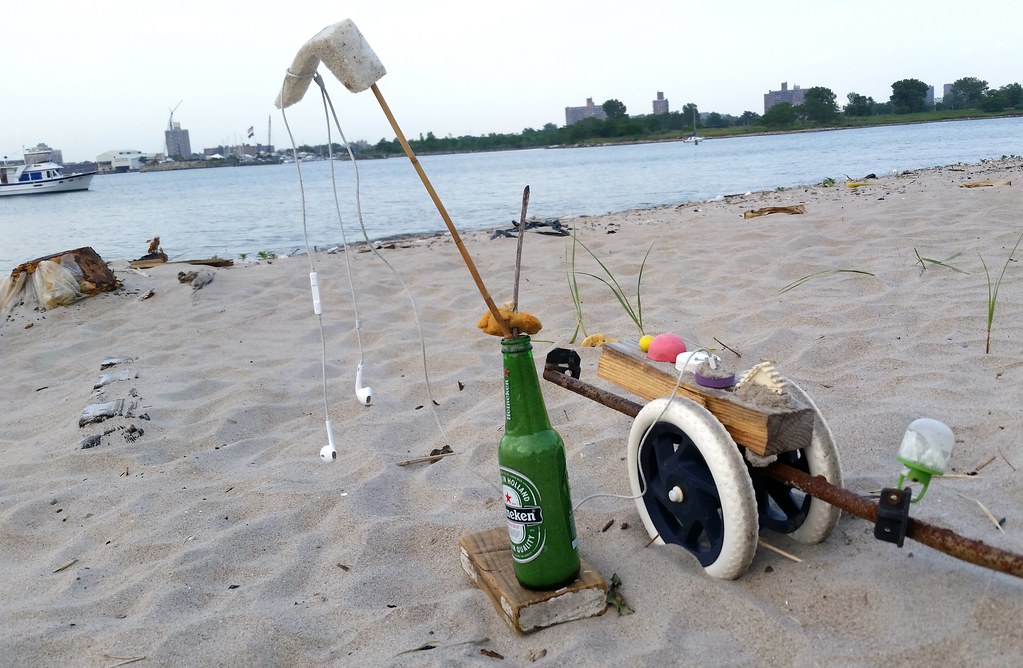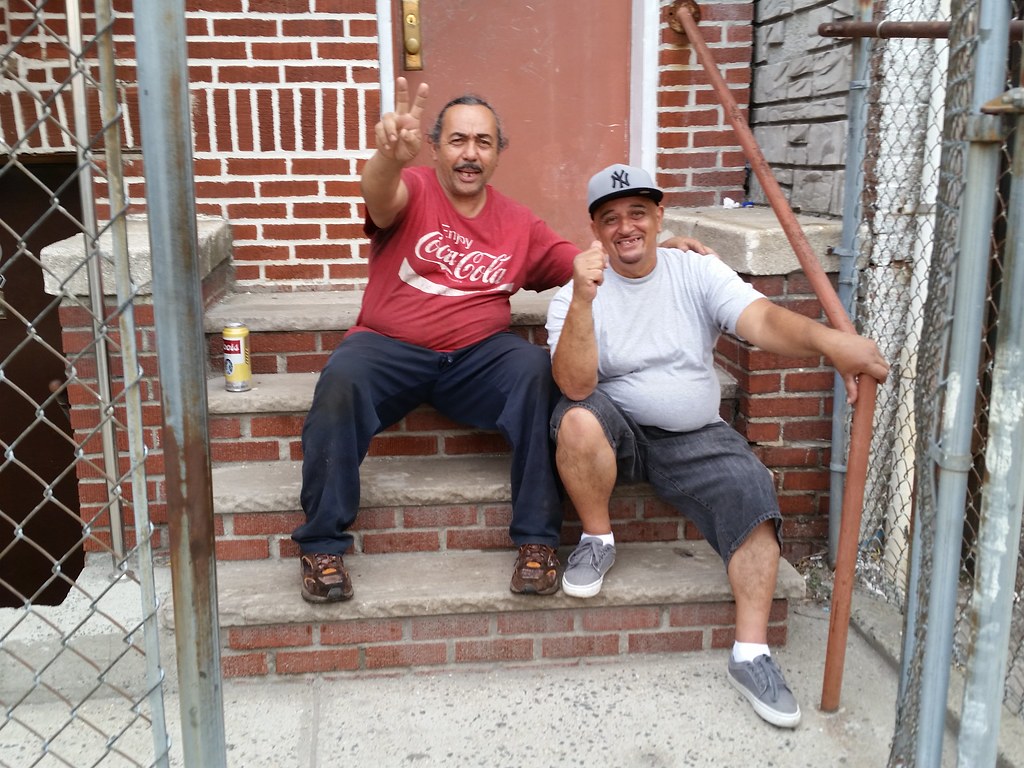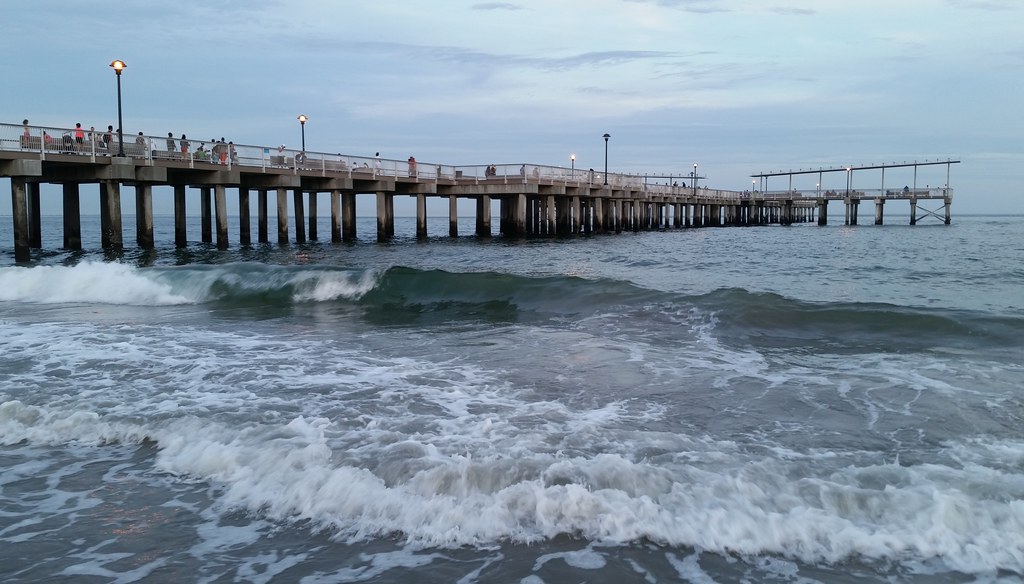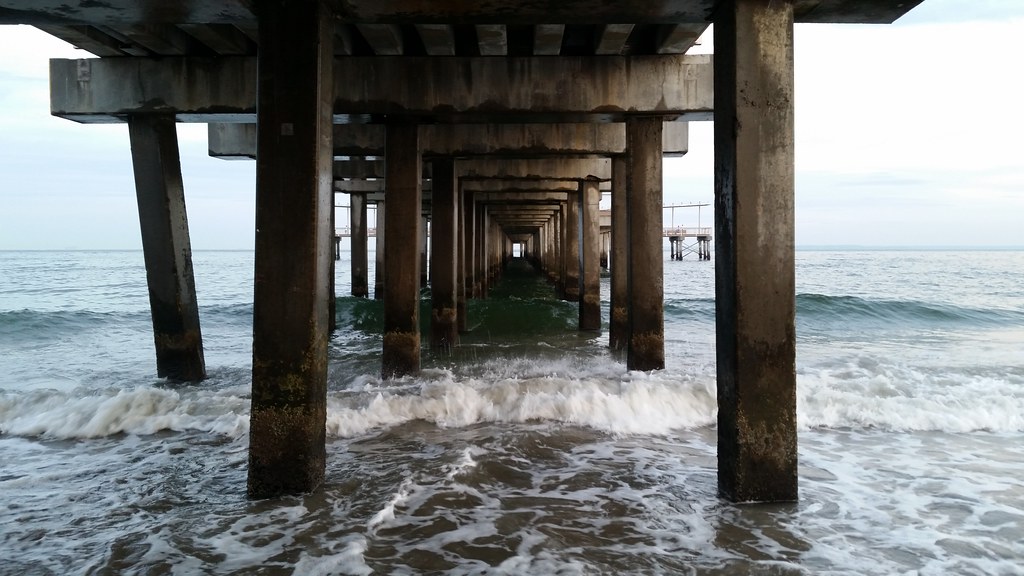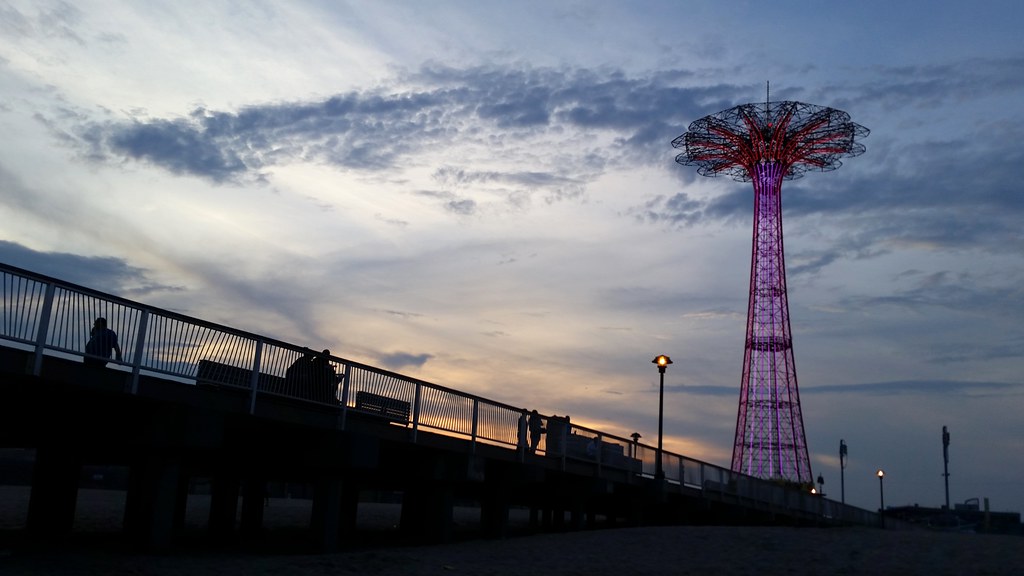

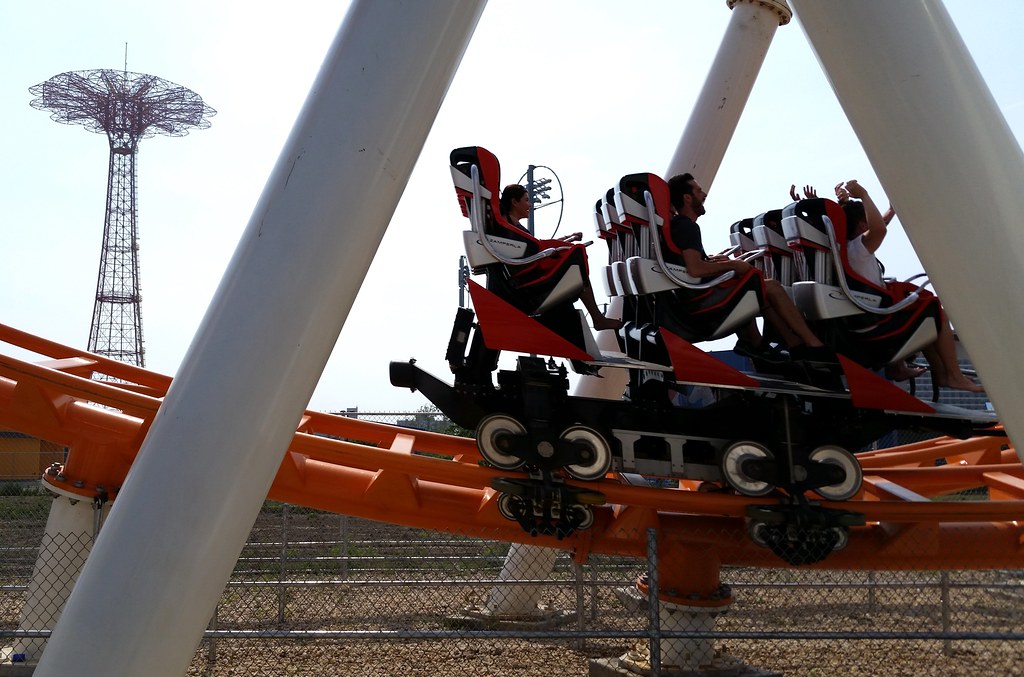


Opened in June 2014, the Thunderbolt replaced a roller coaster of the same name that operated here in Coney Island from 1925 to 1982. You can take a virtual ride on the new Thunderbolt here.
Standing beneath the original Thunderbolt was a large house (photo) — a former hotel — occupied by the family that owned the roller coaster. The house was briefly but memorably featured in the movie Annie Hall as the childhood home of Woody Allen's character, Alvy.
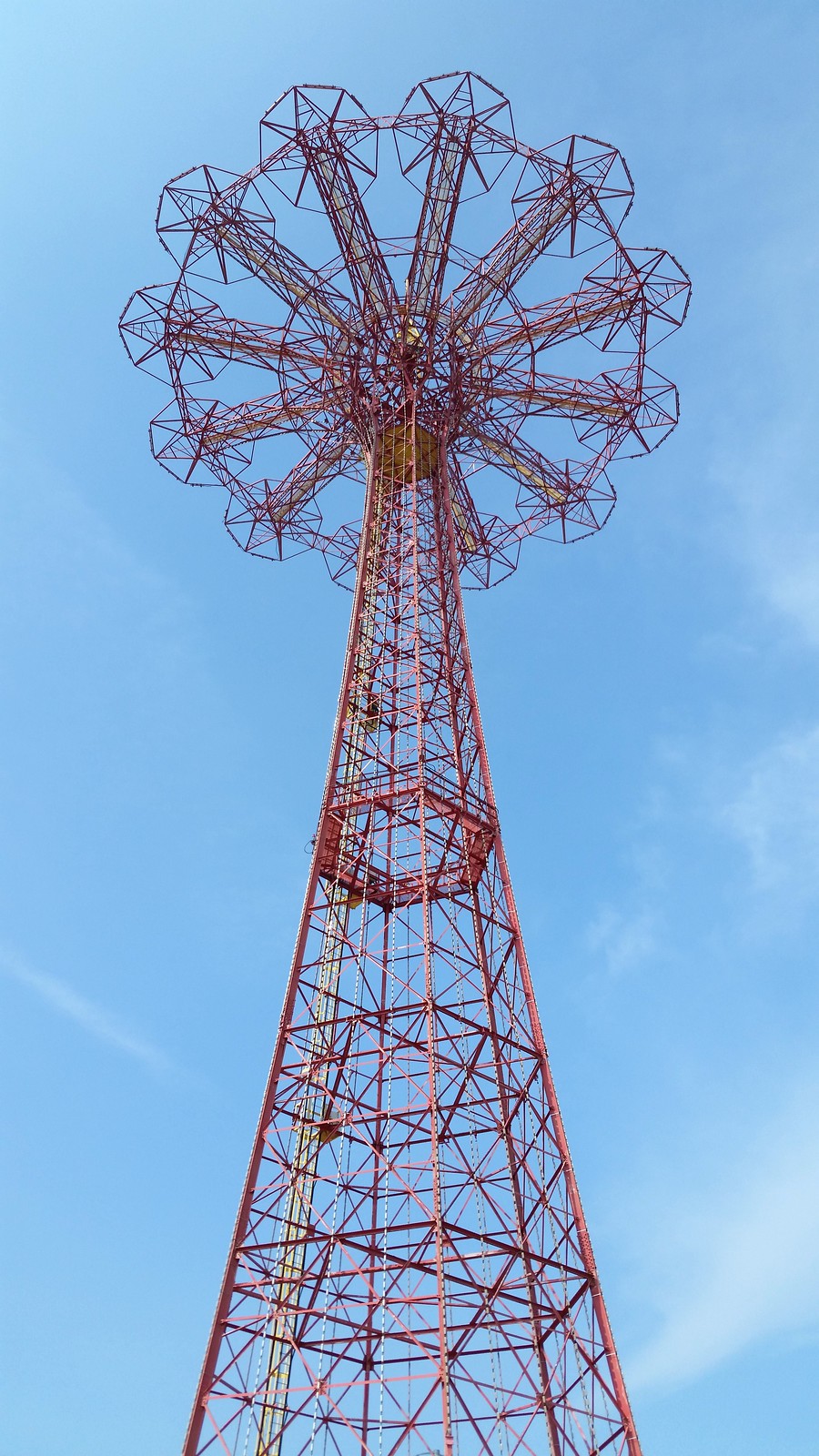
Coney Island's long-defunct Parachute Jump was originally built for the 1939-40 World's Fair in Flushing Meadows, where, in addition to serving as an amusement ride, it was put to use as a monumental flagpole, securing the United States a victory over the Soviet Union in the battle for altitudinal supremacy at the fairgrounds.
The things that look like ropes or cables running vertically up the structure are actually strips of programmable LEDs, part of the Parachute Jump's $2 million lighting system.

Sea Gate is a large gated community at the western tip of Coney Island (aerial view). To keep the grubby public out, each of the two street entrances has a guard on duty at all times. I asked if I could enter as a visitor and walk around, but the guard said no. You can sneak into Sea Gate from the beach, but I figured it would be wise to try to get official permission if I was going to spend hours walking every block in the neighborhood. Walking Sea Gate isn't a necessity for me, since it's a private neighborhood, but I'd do it if I got the chance.
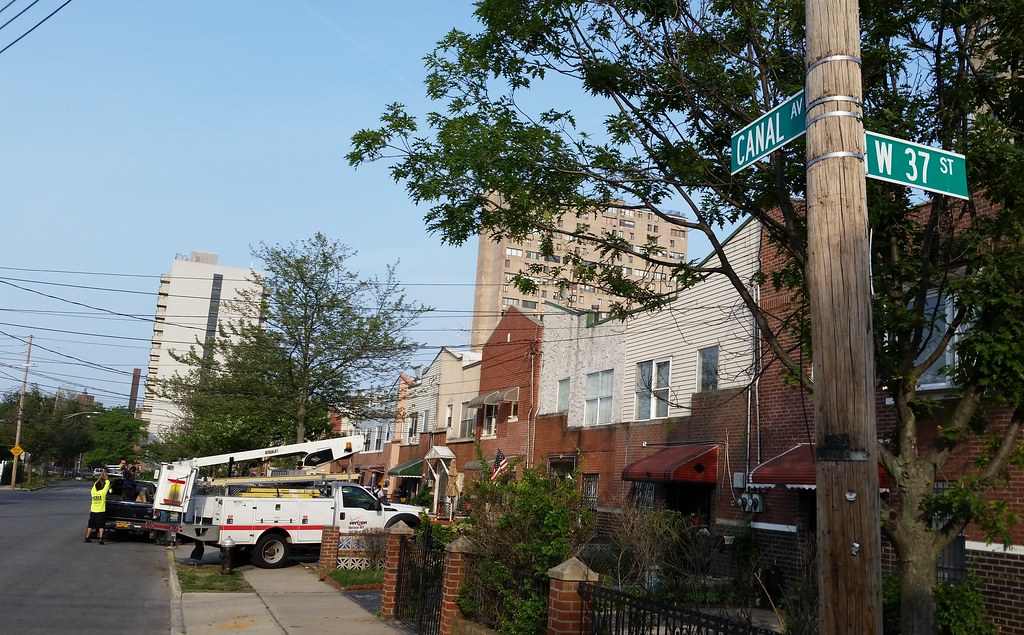
This street is named for the Gravesend Ship Canal, also known as the Coney Island Ship Canal. A noteworthy feature of this canal is that it never existed.
By the late 1800s*, and continuing on through the late 1920s, there were plans to turn the meandering waters of Coney Island Creek into a straight, navigable channel connecting Gravesend Bay and Sheepshead Bay. Maps from that era show the proposed canal flanked by a pair of roadways named Canal Avenue running along its north and south banks.
While the canal never ended up getting built, a few blocks of the southern Canal Avenue were constructed here (1951 aerial view). About one and a half of those blocks remain today (2012 aerial view), still bearing their historically misleading name. There's also one short block named Canal Avenue (formerly two blocks) about a mile east of here, although it's a few hundred feet north of where the proposed northern Canal Avenue appears in the maps linked above.
* The canal can be seen in this map from 1895. This 1879 map makes no mention of the canal itself, but it shows a proposed Canal Avenue.
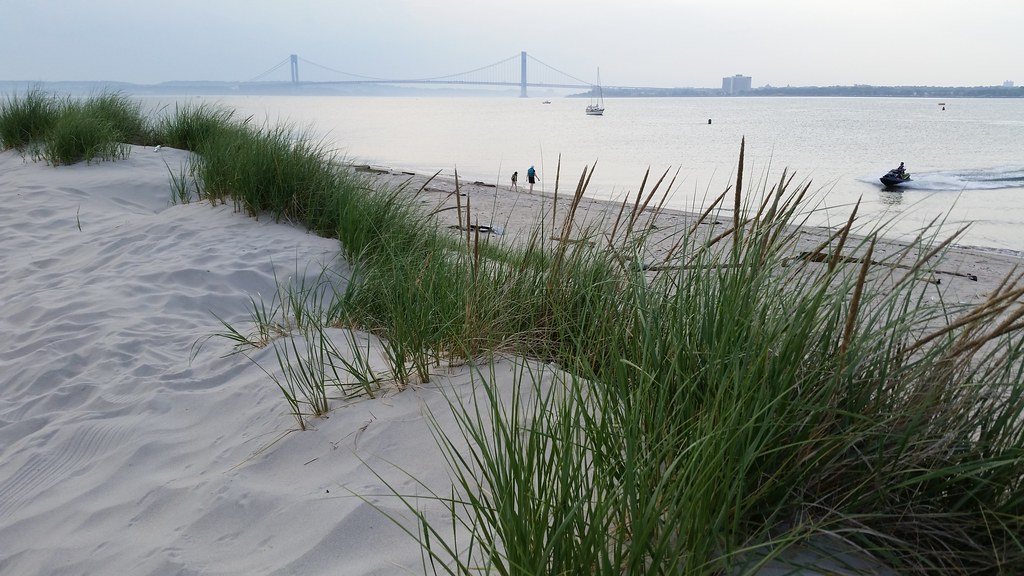
to Gravesend Bay. That's the Verrazano Bridge in the background.
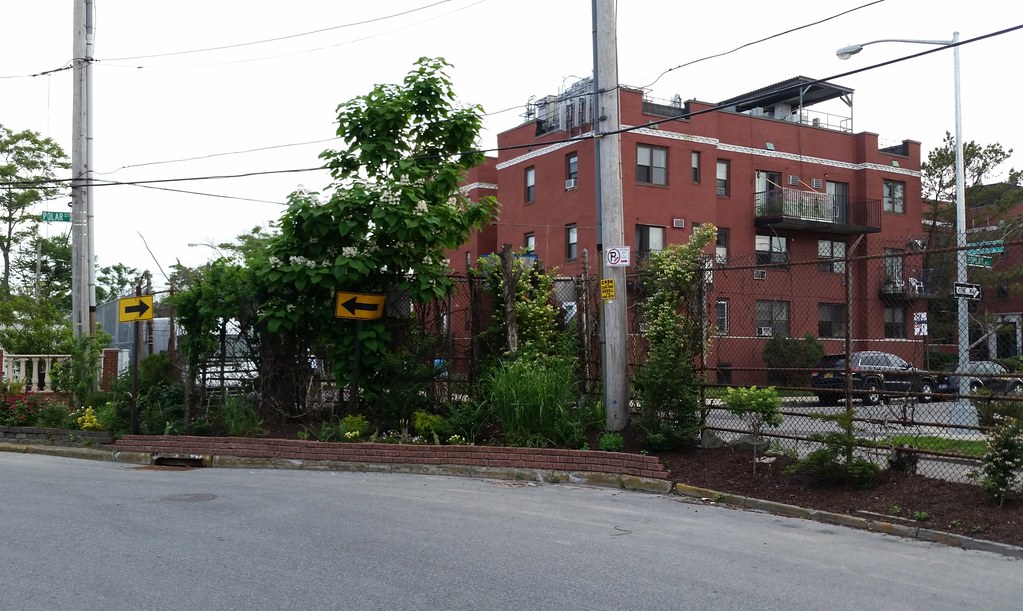
This chain-link fence topped with barbed wire is the barrier between the gated community of Sea Gate (behind the fence) and the public streets of Coney Island. As you can see if you zoom in on the street signs or look at a map, Sea Gate's Poplar Avenue loses a P when it reaches the edge of the neighborhood; it turns into Polar Street on the public side of the fence.
It looks like the entire street was once Poplar, according to maps from 1920 and 1943. This 1949 map is the earliest one I've seen in which Polar makes an appearance. The dashed lines of the 1943 map suggest that the whole street was formerly part of Sea Gate; if that's true, perhaps the eastern portion became Polar when it was excised from the neighborhood and made public.
(According to the NY Times, the red brick structure above is Sea Gate's "one true apartment building".)
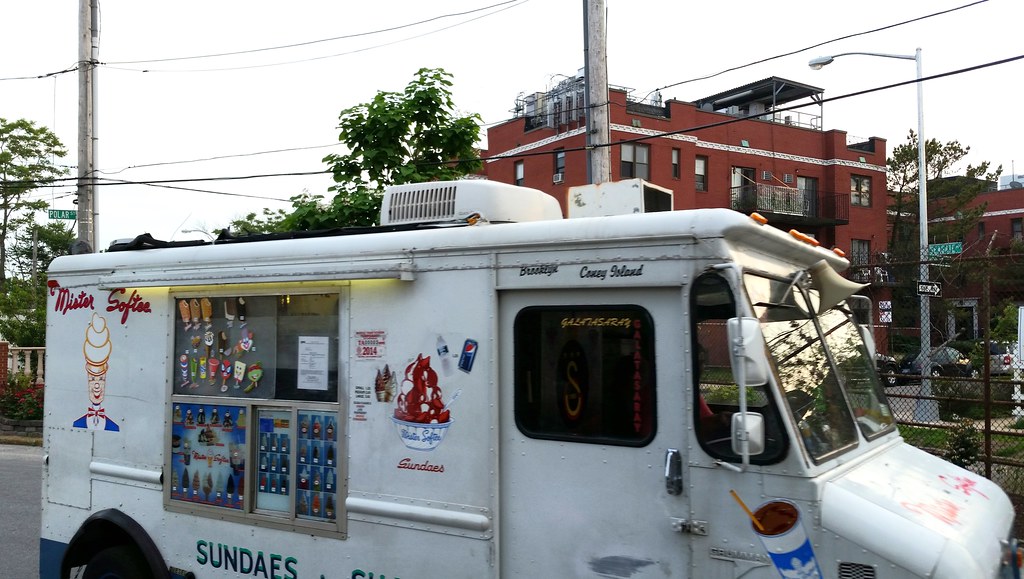
Right after I took the previous photo, a Mister Softee truck drove by. I wasn't paying close attention to it at first, but then I realized that someone inside the gated community of Sea Gate — on the other side of the fence — was calling out to the driver for an ice cream cone. But how would the driver get the man his ice cream? There are no gates in this area, and you can't just throw someone an ice cream cone over a fence... can you? I watched the scene unfold with bated breath.
The driver piled a cone high with chocolate soft-serve, dipped it in chocolate cookie crumbles, then exited the truck and walked over to a particular spot along the fence. There was a small, inconspicuous hole there that someone had cut, just big enough to pass a frosty dessert through. The cone went in, some cash came out, and the truck went on its way.
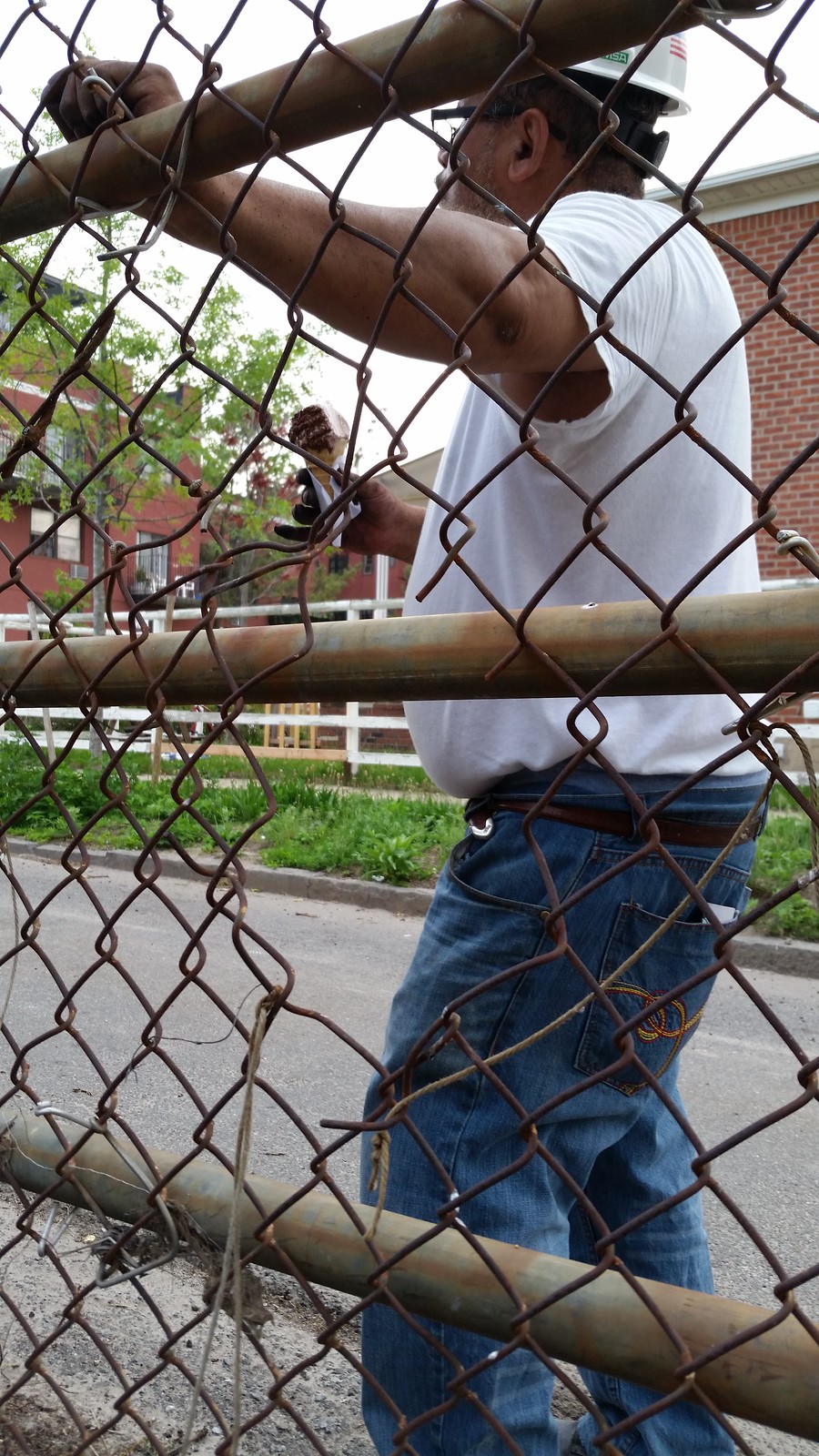
Fascinated by the whole transaction, I started talking to the guy who bought the ice cream, Robert. He said the Mister Softee trucks don't go into Sea Gate — either because they're not allowed in or because they don't want to pay a fee that Sea Gate would charge them — and so he and other nearby residents make their purchases through this hole in the fence.
I told Robert that I wanted to walk around Sea Gate, but that the guard wouldn't let me in. Robert said yeah, you have to be visiting someone to get in if you're not a resident. So I asked Robert if I could visit him, and he said sure. It was too late to walk the whole neighborhood today, so I made plans to call him up and schedule a visit sometime in the next few months. In other words: Stay tuned for more captivating tales from the forbidden land of Sea Gate!

When you think of Woody Guthrie, the legendary folk singer from Oklahoma, it's easy to picture him as an itinerant Dust Bowl balladeer, roaming and rambling through the rural landscapes of "This Land Is Your Land". But that song also mentions "the New York island", and Woody, who spent most of the latter half of his life in the Big Apple, was just as much of a city dweller as he was anything else.
Foremost among his urban residences was 3520 Mermaid Avenue, a brick row house in Coney Island that stood on the site now occupied by the senior-citizen apartment tower pictured above. He lived here from 1943 to 1950, sharing a one-bedroom apartment with his second wife Marjorie and their children (including Arlo, born in 1947). Among his favorite Coney Island activities: building sand castles on the beach with the kids (his own and others) and going to Nathan's Famous for hot dogs and "hot patooties" (french fries).
Woody lived out his last relatively healthy years here on Mermaid Avenue. In the late 1940s, when he was in his mid-to-late 30s, his behavior started becoming "increasingly erratic, moody and violent"; these changes were early symptoms of what turned out to be Huntington's disease, the vicious neurodegenerative disorder that killed his mother. By 1954, he was in the hospital for good; he would remain in one institution or another for the next 13 years while the disease gradually ate away at his brain. Woodrow Wilson Guthrie finally died in 1967 at the age of 55 at Creedmoor State Hospital in Queens.
A prolific songwriter, Woody left behind a vast trove of unrecorded lyrics. Over the years, his daughter Nora has invited a number of artists to comb through the archive and write music for his orphaned songs. The first of these collaborations, with Billy Bragg and Wilco, resulted in 1998's beautiful and critically acclaimed album Mermaid Avenue, and generated enough material for two subsequent releases. You can listen to all three Mermaid Avenue records here: the original, Vol. II, and Vol. III.
Let's close with Woody's own tribute to his Coney Island street, a song he called "Mermaid's Avenue":
Mermaid Avenue that’s the street
Where the lox and bagels meet,
Where the sour meets the sweet;
Where the beer flows to the ocean
Where the wine runs to the sea;
Why they call it Mermaid Avenue
That’s more than I can see.
CHORUS:
But there’s never been a mermaid here
On Mermaid Avenue
No, I’ve never seen a mermaid here
On Mermaid Avenue
I’ve seen hags and wags and witches;
And I’ve seen a shark or two
My five years that I’ve lived along
Old Mermaid’s Avenue
Mermaid Avenue that’s the street
Where the saint and sinners meet;
Where the grey hair meets the wave curls
Where the cops don’t ever sleep;
Where they pay some cops to stop you
When you hit that Sea Gate* gate;
Where them bulls along that wire fence
Scare the mermaids all away
Mermaid Avenue that’s the street
Where the sun and storm clouds meet;
Where the ocean meets that rockwall
Where the boardwalk meets the beach;
Where the prettiest of the maidulas
Leave their legprints in that sand
Just beneath our lovesoaked boardwalk
With the bravest of our lads.
CHORUS
Mermaid Avenue that’s the street
Where all colors of goodfolks meet;
Where the smokefish meets the pretzel
Where the borscht sounds like the seas;
This is where hot Mexican Chili
Meets Chop Suey and meatballs sweet;
Mermaid Avenue she’s a nervous jerk
But, still, she’s hard to beat.
* Woody lived in Sea Gate for at least two short periods of time. In 1943, not long before his first stint in the Merchant Marine, he moved in with Marjorie and their infant daughter in "a tiny room above [Marjorie's] parents' apartment". And in 1948, he rented a room in the gated community during a brief separation from Marjorie.
UPDATE: When they left Mermaid Avenue in 1950, Woody and his family moved to the Beach Haven apartment complex, a development near Coney Island built and operated by Fred Christ Trump, Donald Trump's father. Woody wasn't a huge fan of his new landlord:
I suppose
Old Man Trump knows
Just how much
Racial Hate
he stirred up
In the bloodpot of human hearts
When he drawed
That color line
Here at his
Eighteen hundred family project
Read more here.
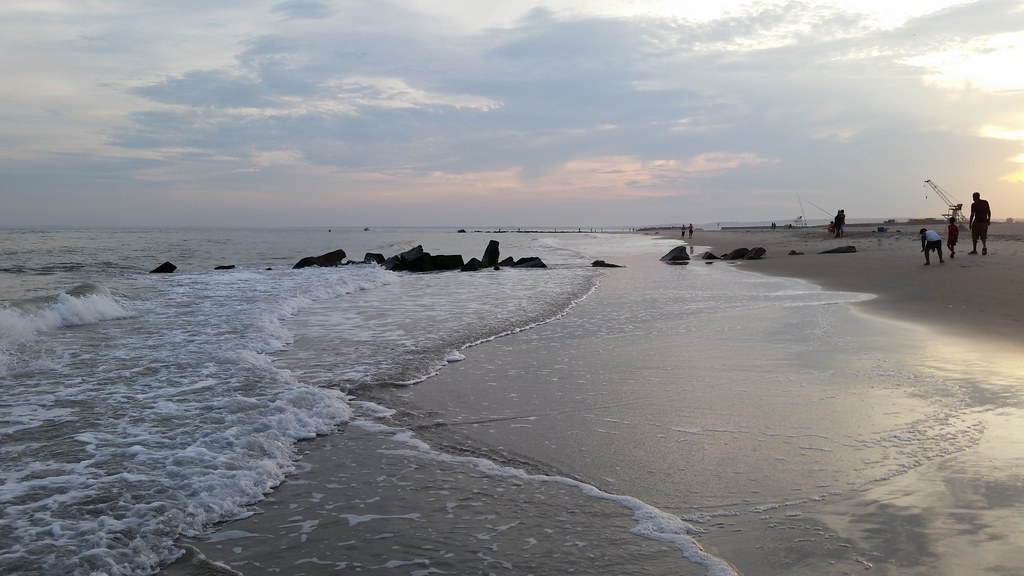
The stone groin jutting into the water in the distance (with the fishermen standing on it; zoom in) is where Woody Guthrie's family tossed his ashes into the ocean after he died in 1967.


